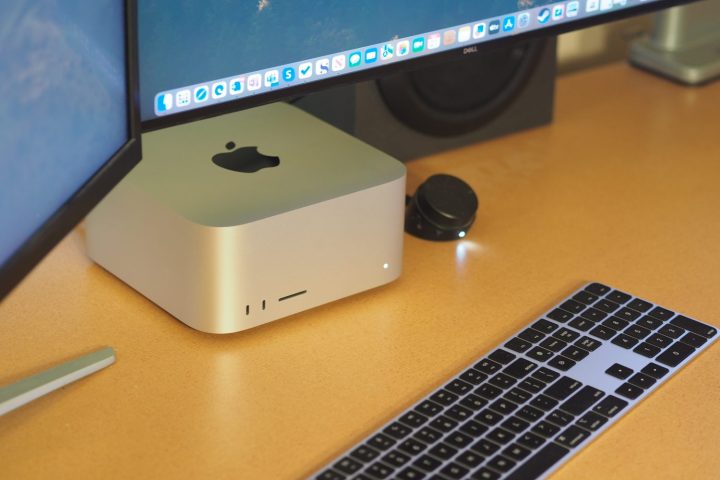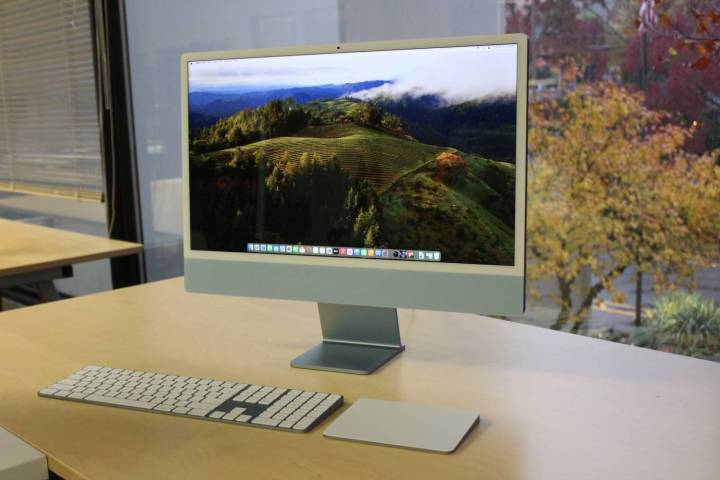

In the last two years, Apple has released three new Mac desktop computers, all based on Apple Silicon, yet these systems are wildly different. The new Mac Studio sits at the top, with the iMac and Mac mini filling the lower tiers. Of course, there’s the Mac Pro too, but we’ll set that aside for now in this comparison.
In one sense, it’s simple — the most expensive model has the greatest performance. However, several thousand dollars might be wasted if it’s meant to be used for tasks that wouldn’t even stress the cheapest model, which is also quite speedy. More than that, some blurred lines between configurations of these Macs can make the decision more complicated. Here’s what to consider when buying a new desktop Mac.
Start with the iMac


Apple updated its iMac in 2023, giving it an M3 processor and refreshing the design with an ultra-slim 24-inch display. Starting at $1,299, it’s an all-in-one computer that completely eliminates the hassle of building a system. The M3 iMac comes with a Magic Mouse and Magic Keyboard, a big screen, and a 1080p webcam, so it only needs to be unboxed and plugged in to begin using it.
Since an iMac includes a screen, that’s an important factor when considering this computer. Is the display big enough, sharp enough, and bright enough? For most people, the 24-inch iMac display will look fantastic. With a 4.5K resolution and measuring 24 inches diagonally, it’s a large and crisp display that also boasts 500 nits of brightness. An expensive monitor, such as an Apple Studio Display or a pricey third-party monitor, would be needed to beat the iMac display.
So, if you’re someone who likes the idea of an all-in-one solution in a self-contained unit, it doesn’t get much simpler or more convenient than the iMac. It comes with everything you need in the box and is a fantastic machine to boot. However, it doesn’t include many ports, and the performance is limited to just the M3. No Pro or Max models are available, meaning if you’re a content creator in some fashion, you might want to consider one of the more powerful options.
The Mac mini is a super-cheap alternative
The Mac mini is a low-cost alternative that still packs a punch. Buying an M2 Mac mini for just $599 is possible, making it the cheapest possible Mac in the entire lineup. Of course, that doesn’t include anything beyond the tiny 1.4-inch tall computer and its power cord. However, for a budget computer, it’s a fair assumption that reusing existing accessories is OK. Plug in your existing monitor, keyboard, and mouse to use the Mac mini to power through everyday tasks quickly and efficiently while leaving plenty of cash to purchase apps and upgrade accessories.
Its M2 processor equals the performance of the M2 chip found in the previous generation MacBook laptops and can’t compete with the M3, M3 Pro, and M3 Max-powered computers that launched in 2023. And the Mac mini can be configured with the faster M2 Pro at a premium price.
That doesn’t mean it’s a slow computer, though. The Mac mini can run single-core tasks nearly as fast as an M2 Ultra, which is the computer’s most common use. The difference might show when processing videos, crunching a massive spreadsheet, running a demanding game, or handling heavily multilayered images or audio files. For browser tasks, photo adjustments, page layout, and word processing, an M2 Pro chip blazes through most jobs with no problem and rarely needs to be cooled by the fan.
If you’ve already got a monitor and set of accessories you like — or perhaps you like the entire of choosing your own — the Mac mini is a great place to start. It’s compact, affordable, and powerful (especially with the M2 Pro onboard).
The Mac Studio is only for those who need it
Apple’s Mac Studio is an exciting desktop PC with incredible performance in a small package, and there’s no doubt it would be a great machine for anyone. There is a significant barrier for most shoppers, though, as the Mac Studio starts at $1,999 for just the mini-tower and power cord. Adding an Apple Studio Display, keyboard, and mouse bumps the price up to $3,896. Choosing the highest performance configuration more than doubles the cost to $7,999, making this a super powerful yet very expensive system.
With the option for an M2 Max with 12 CPU cores and 30 or 36 GPU cores or an M2 Ultra processor, which boasts 24 CPU cores and 60 or 76 GPU cores, the Mac Studio reigns supreme in Mac desktop performance, even beating the Mac Pro that towers above it in a massive 40-pound case. The Mac Studio fits into a remarkably small 7.7-by-7.7-by-3.7-inch body and weighs under 8 pounds.
Apple has subsequently released new M3 chips, with the M3 Max being roughly as fast as the M2 Ultra in CPU-intensive tasks and faster in GPU-intensive processes, but the Mac Studio remains a very fast PC with relatively low energy demands and a quiet and low-temperature design. Once more, Apple is pushing the PC industry to go further with its advanced chip technology that’s closely related to the processor used in an iPhone.
While there’s no doubt that the Mac Studio is a powerhouse that will meet almost any need, most people simply don’t require that much performance and it would make more sense to consider Apple’s other Macs first. You also have the M3 MacBook Pro to think about, which makes for surprisingly good alternative.
Which Mac is right for you?
The iMac is going to continue to be the most popular option — and for good reason. The 2023 M3 iMac, with its bright and crisp 24-inch display, is a great all-in-one solution. At $1,299, it handles most daily computing needs and looks great on a desk, keeping everything tidy and compact with the focus entirely on the screen, keyboard, and mouse. As a first computer or when upgrading every component at once, it’s hard to beat.
There are a few reasons to opt for the Mac mini instead. Namely, the $599 price makes it the cheapest way into the Mac ecosystem. So, if you already own a monitor that you like, the Mac mini is an affordable way to update your setup or switch to a Mac. It’s also good for those who want a more robust set of ports for your desk setup over what’s available on the iMac. The fact that you can even configure it with up to the M2 Pro makes it even more versatile.
The Mac Studio is a much more niche device, really only for those who might really need the extra performance. The base model contains an M2 Max chip that blasts through heavy workloads with four times the performance of an M1. If there is a need for more than 16GB of memory, the Mac Studio starts with 32GB and reaches as high as 128GB. This allows larger datasets to reside in memory so the processor doesn’t have to wait for information to be retrieved from storage. The $1,999 starting price is over double that of the Mac mini but is often worth the cost when used for work.
Editors’ Recommendations

